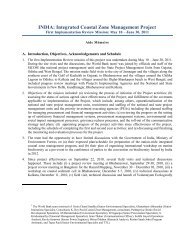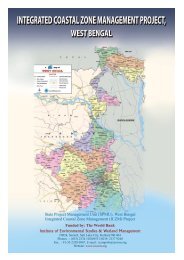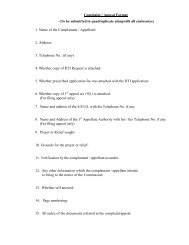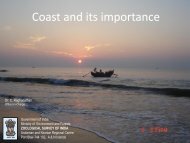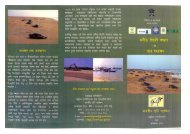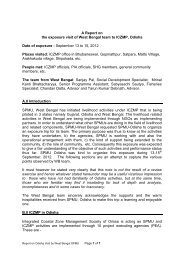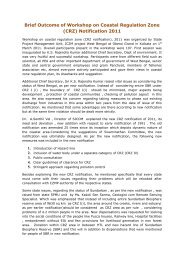- Page 2 and 3: HAZARD ASSESSMENT AND DISASTER MITI
- Page 4 and 5: Project Team Though the outcome of
- Page 6 and 7: Preamble The State of West Bengal,
- Page 8 and 9: 1.2 IMD, in its website (http://www
- Page 10 and 11: 1.4 5. Proposals for location of cy
- Page 12 and 13: 2.2 region is that which struck the
- Page 14 and 15: 2.4 Figure 2-2. Track of the 1970 B
- Page 16 and 17: 2.6 The most destructive element as
- Page 18 and 19: 2.8 the two regions is rather diffe
- Page 20 and 21: 2.10 2.4. The eastern coastal zone
- Page 24 and 25: 2.14 Strong winds known as cyclones
- Page 26 and 27: 2.16 2.4.6. Soil characteristics Th
- Page 28 and 29: 2.18 All rivers have in general sou
- Page 30 and 31: 2.20 Another interesting feature of
- Page 32 and 33: 2.22 formed does not pose so much o
- Page 34 and 35: 2.24 2.4.11. Forest composition The
- Page 36 and 37: 2.26 Canning (Bidyadhari Outfall in
- Page 38 and 39: 2.28 Administrative information Pop
- Page 40 and 41: 2.30 Mangrove plantation beyond the
- Page 42 and 43: 2.32 A retired embankment of river
- Page 44 and 45: 2.34 The beaches are flattened by s
- Page 46 and 47: 2.36 of a doiminant tidalbasin of t
- Page 48 and 49: 2.38 primary mode is centered on th
- Page 50 and 51: 2.40 Aquaculture ponds located betw
- Page 52 and 53: 2.42 All the islands are situated w
- Page 54 and 55: 2.44 • Transport the water to the
- Page 56 and 57: 2.46 The other type of failure may
- Page 58 and 59: 2.48 channel floor, some of the riv
- Page 60 and 61: 2.50 embankments. Crops and propert
- Page 62 and 63: 2.52 2. To reduce the average dista
- Page 64 and 65: 3.2 a storm surge caused by a tropi
- Page 66 and 67: 3.4 these merchants may have been t
- Page 68 and 69: 3.6 Figure 3-1. Map of India during
- Page 70 and 71: 3.8 larger volume of sewage and dra
- Page 72 and 73:
3.10 receive, at least during the r
- Page 74 and 75:
3.12 3.9. Drainage scheme of Dr. B.
- Page 76 and 77:
3.14 3.10. CMPO and KMDA (originall
- Page 78 and 79:
3.16 Flows are diverted to the loca
- Page 80 and 81:
3.18 the Bhangar region through the
- Page 82 and 83:
3.20 the ocean level as a result of
- Page 84 and 85:
3.22 Table 3-6. Major pumping stati
- Page 86 and 87:
3.24 Table 3-9. Drainage basin area
- Page 88 and 89:
3.26 will lead to significant impro
- Page 90 and 91:
3.28 locks, one at Chitpur and anot
- Page 92 and 93:
3.30 Respectively. The discharge of
- Page 94 and 95:
3.32 Figure 3-6. The downstream of
- Page 96 and 97:
3.34 Figure 3-10 shows the tail end
- Page 98 and 99:
3.36
- Page 100 and 101:
3.38
- Page 102 and 103:
4.2 In US, there is a steady decrea
- Page 104 and 105:
4.4 This shows that Orissa (with 10
- Page 106 and 107:
4.6 30 25 20 15 10 Severe Cyclone C
- Page 108 and 109:
4.8 Table 3: Return periods of cycl
- Page 110 and 111:
4.10 Table 5: The number and return
- Page 112 and 113:
4.12 work station (the Automated Tr
- Page 114 and 115:
4.14 through this trough into the d
- Page 116 and 117:
4.16 Mean Low water 1.51 1.39 1.34
- Page 118 and 119:
4.18 τx,τy : x and y components o
- Page 120 and 121:
4.20 formulation. However, the rete
- Page 122 and 123:
4.22 ∂u ~ ∂ ~ ~ ∂ ~ ~ ∂ζ 1
- Page 124 and 125:
4.24 Δ p p(r) = p( ∞) − [1+ (r
- Page 126 and 127:
4.26 maximum surge for this event w
- Page 128 and 129:
4.28 U-Component of Velocity (Surfa
- Page 130 and 131:
4.30 ## ## ## #### ### ## ########
- Page 132 and 133:
4.32 V-component of Velocity (Surfa
- Page 134 and 135:
4.34 U-component of Velocity (Surfa
- Page 136 and 137:
## ################################
- Page 138 and 139:
4.38 V-Component of velocity (Surfa
- Page 140 and 141:
5.2 particular human settlement to
- Page 142 and 143:
5.4 The Composite Vulnerability Ind
- Page 144 and 145:
5.6 (2004 prices) prevalent in dist
- Page 146 and 147:
5.8 Moyna 0.6280 0.1592 0.542286 0.
- Page 148 and 149:
5.10 5.4.2. Social infrastructure H
- Page 150 and 151:
5.12 Budge-Budge(Part-II) 0.0000 0.
- Page 152 and 153:
5.14 secondary and tertiary activit
- Page 154 and 155:
5.16 F i Fˆ i ⎛ Total no. of =
- Page 156 and 157:
5.18 Table 5-4: Composite Index of
- Page 158 and 159:
5.20 M ′ = H M ′′ = I . S whe
- Page 160 and 161:
Chapter Six Mitigation Strategies a
- Page 162 and 163:
6.3 Beside these differences in lev
- Page 164 and 165:
6.5 • to reduce the destructive f
- Page 166 and 167:
6.7 6.2.4. Methods of Construction
- Page 168 and 169:
6.9 is attached to the structure. T
- Page 170 and 171:
6.11 (b) Medium rivers to armour th
- Page 172 and 173:
6.13 Likewise, in all the embankmen
- Page 174 and 175:
6.15 Figure 6 -5 Figure 6 -6 Figure
- Page 176 and 177:
6.17 Benefit cost ratio Area benefi
- Page 178 and 179:
6.19 Location and cost of proposed
- Page 180 and 181:
6.21 Swaraupnagar Swaraupnagar 100
- Page 182 and 183:
6.23 Gobadia Kakdwip Dk Kasiabad &
- Page 184 and 185:
6.25 Location and cost of proposed
- Page 186 and 187:
6.27 " Jagaddal " 800 6400000 " Jag
- Page 188 and 189:
6.29
- Page 190 and 191:
6.31
- Page 192 and 193:
6.33
- Page 194 and 195:
6.35 Figure 6 -11 Figure 6 -12
- Page 196 and 197:
6.37 Figure 6 -15 Figure 6 -16
- Page 198 and 199:
6.39 Figure 6 -19 6.2.7. Recommenda
- Page 200 and 201:
6.41 4. Rajraj Swarup & Ramnagar Ab
- Page 202 and 203:
6.43 project. Such sediment deficit
- Page 204 and 205:
6.45 paludosa, Rhizophora apiculata
- Page 206 and 207:
6.47 15. Ceriops tagal 0.22 0.40 0.
- Page 208 and 209:
6.49 shelterbelt (average 100 m wid
- Page 210 and 211:
6.51 (assuming land acquisition cos
- Page 212 and 213:
6.53 location are missing reducing
- Page 214 and 215:
7.2 resulted in large scale waterlo
- Page 216 and 217:
7.4 5. No adverse effect in drainin
- Page 218 and 219:
7.6 15 LT Panel L.S. 2,200,000 16 I
- Page 220 and 221:
7.8 Bagjola, Kestopur and SWF chann
- Page 222 and 223:
Executive Cost Summary of Recommend
- Page 224 and 225:
References Kanjilal (2005) “Sunde
- Page 239:
“……………….Designingadis









